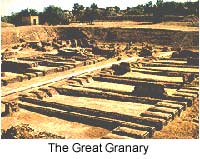

 |  |
 Food: Specimens of wheat and barley show that they were cultivated in that region. Rice was also probably grown. There is evidence to show that date palms were grown in the area. Besides these, the diet of the people consisted of fruits, vegetables, fish, milk and meat of animals i.e. beef, mutton and poultry.
Food: Specimens of wheat and barley show that they were cultivated in that region. Rice was also probably grown. There is evidence to show that date palms were grown in the area. Besides these, the diet of the people consisted of fruits, vegetables, fish, milk and meat of animals i.e. beef, mutton and poultry.
Dress: From the sculptured figures it can be seen that the dress of men and women consisted of two pieces of cloth-one resembling a dhoti, covering the lower part, and the other worn over the left shoulder and under the right arm. Men had long hair designed differently. Women wore a fan shaped head dress covering there hair. The discovery of a large number of spindles showed that they knew weaving and spinning. Similarly it was concluded, by the discovery of needles and buttons, that the people of this age knew the art of stitching. Ornaments: Both men and women wore ornaments made of gold, silver, copper and other metals. Men wore necklaces, finger rings and armlets of various designs and shapes. The women wore a head dress, ear rings, bangles, girdles, bracelets and anklets. Rich people wore expensive ornaments made of gold while the poor had ornaments made of shell, bone or copper. Cosmetics: The ladies of Mohen-jo-daro were not lagging behind in styles as used by the ladies of the present day, when it came to the use of cosmetics and the attainment of beauty. Materials made of ivory and metal for holding and applying cosmetics prove that they knew the use of face paint and collyrium. Bronze oval mirrors, ivory combs of various shapes, even small dressing tables, have been found at Mohen-jo-daro and other sites. Women tied the hair into a bun and used hair pins made of ivory. Toilet jars, found at Mohen-jo-daro, show that women took interest in cosmetics. Furniture and Utensils: The furniture and utensils found at Mohen-jo-daro show a high degree of civilization because of their variety in kind and design. The beautifully painted pottery, numerous vessels for the kitchen, chairs and beds made of wood, lamps of different material, toys for children, marbles, balls and dice, indicate what people manufactured in those days. Conveyance A copper specimen found at Harappa resembles the modern Ekka (cart) with a top-cover. Bullock carts with or without the roof was the chief means of conveyance. Amusements and Recreation: The Indus Valley people liked more of indoor games than outdoor amusements. They were fond of gambling and playing dice. Dancing and singing were considered great arts. Boys played with toys made of terracotta, while girls played with dolls. next page >> |
Copyright ©2000 indiansaga.info. All rights reserved.
By using this service, you accept that you won't copy or use the data given in this website for any commercial purpose.
The material on indiansaga.info is for informational & educational purpose only.
This site is best viewed at 800 X 600 picture resolution.